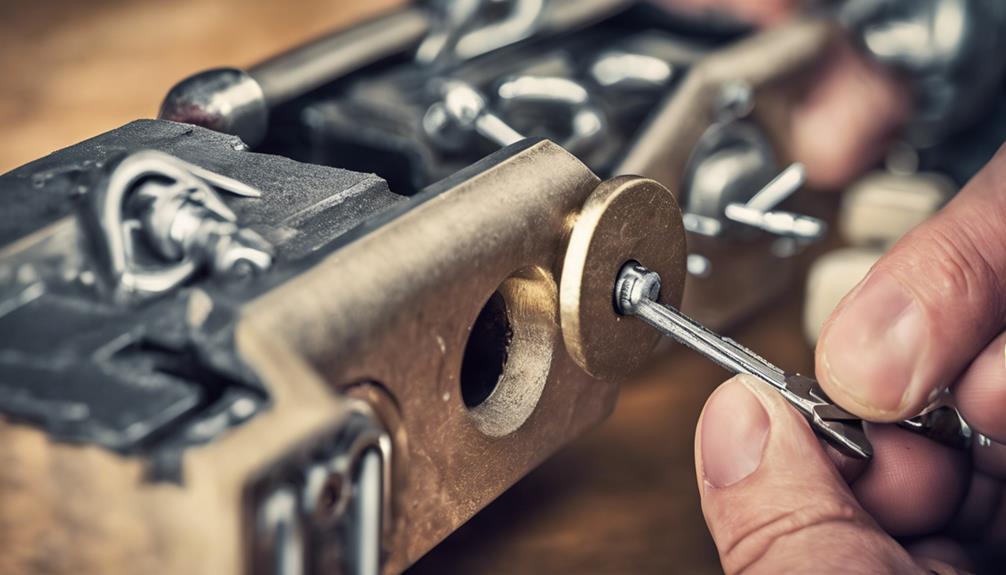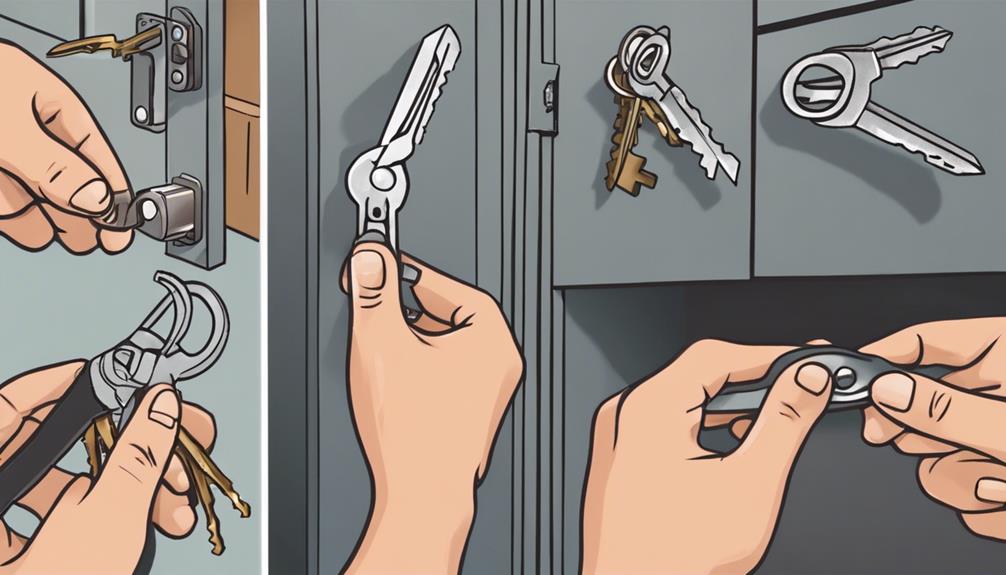If your lock is jammed or a key is broken inside it, don't panic. First, assess the situation by checking for visible obstructions or damages. Try using lubricant like WD-40 to loosen the mechanisms. Use pliers or tweezers to carefully extract the broken key. Avoid forcing the key to prevent further damage. If the issue persists, call Low Rate Locksmith Hour Mobile Nationwide for professional assistance. Avoid DIY methods that can worsen the problem. Stay calm and patient throughout the process. Taking these initial steps can help resolve the issue efficiently.
Key Takeaways
- Avoid forcing the key; use gentle techniques like jiggling or tapping.
- Apply lubricant like graphite powder or WD-40 for stuck locks.
- Use appropriate tools like pliers or tweezers for key extraction.
- Seek professional locksmith help if DIY methods fail.
- Stay calm, patient, and avoid rushing to prevent further damage.
Assess the Situation

When faced with a jammed lock or a broken key, the first step is to assess the situation carefully. Proper assessment is essential for determining the root cause of the issue and deciding on the best course of action. Start by examining the lock mechanisms to see if there are any visible obstructions or damages. Sometimes a simple troubleshooting technique like jiggling the key or gently tapping the lock can help loosen things up. Avoid the temptation to force the key, as this could worsen the situation. If you notice any bent parts or debris inside the lock, it might be time to call in a professional locksmith. Remember, patience is key when dealing with lock issues. Stay calm, assess the problem, and don't be afraid to seek expert help if needed.
Try Using Lubricant
When facing a jammed lock or a broken key, using lubricant can often be your first aid solution. It's essential to choose the right type of lubricant that is suitable for locks to avoid causing further damage. Applying the lubricant effectively by targeting the keyway and gently maneuvering the key can help loosen the stuck components.
Lubricant as First Aid
If you find yourself faced with a jammed lock or a broken key, consider using lubricant as your first line of defense. Lubricants can work wonders in loosening up stuck mechanisms and making your life easier. Below is a quick guide to lubricant types for lock maintenance:
| Lubricant Type | Best For | Not Recommended |
|---|---|---|
| Graphite Powder | Internal lock parts | Outdoor locks |
| WD-40 | General lubrication | Long-term protection |
| Silicone Spray | Long-lasting effect | Attracting dirt |
Choosing the Right Lubricant
Opt for the right lubricant to effectively address a jammed lock or a broken key. When choosing the right lubricant, consider these three essential factors:
- Graphite Lubricant: Ideal for locks, this dry lubricant reduces friction without attracting dirt and debris.
- Silicone Spray: Great for both indoor and outdoor locks, it repels moisture and protects against rust and corrosion.
- WD-40: A versatile option that can help loosen stuck mechanisms and displace moisture in a pinch.
Applying Lubricant Effectively
To effectively address a jammed lock or a broken key, applying lubricant is key. When it comes to lock maintenance, using the right lubricant can work wonders. Different lubricant types are available, such as graphite powder or silicone spray. Graphite powder is excellent for dry environments, while silicone spray works well in damp conditions. To apply the lubricant effectively, insert the nozzle into the keyhole and give it a good spray or puff of powder. Then, insert and remove the key several times to distribute the lubricant evenly. Remember, a well-lubricated lock is a happy lock! Keep those keys turning smoothly with a little TLC and the right lubricant for the job. Don't forget to check out these Essential Tips to keep your locks rust-free and functional.
Use Pliers or Tweezers

When dealing with a jammed lock or a broken key, utilizing pliers or tweezers can be a game-changer. Selecting the right tool is essential to successfully removing the broken key. Remember to exercise caution throughout the process to avoid causing further damage to the lock or key.
Selecting the Right Tool
Frequently, when faced with a jammed lock or broken key, selecting the right tool can make all the difference in resolving the issue efficiently. When dealing with different lock types, such as padlocks or door locks, having the appropriate tool is essential. Here are three tips to help you choose the right tool for the job:
- For Padlocks: Opt for sturdy pliers with a good grip to maneuver around the lock effectively.
- For Door Locks: Consider using tweezers with a fine tip to carefully extract the broken key without causing further damage.
- Universal Tool: Keep a multitool handy for versatility in handling various lock types and key extraction scenarios. Remember, the right tool can turn a frustrating situation into a quick fix!
Removing Broken Key
To successfully remove a broken key from a lock, utilizing either pliers or tweezers can be a straightforward yet effective solution. Key extraction techniques like these can save the day when your key decides to play hide and seek within the lock. Simply grab a trusty pair of pliers or tweezers, gently insert them into the keyway, and carefully pull out the broken key fragment. It's like performing a delicate operation, but with less pressure and more room for error. These tools are like the superheroes of lock repair tools, swooping in to save the day when things seem dire. So, next time your key decides to break inside the lock, remember that pliers and tweezers are your trusty sidekicks in this key-extracting adventure!
Exercising Caution Throughout
To guarantee a safe and successful broken key extraction process using pliers or tweezers, it is essential to exercise caution throughout. Here are three vital safety precautions you should follow:
- Secure the Area: Make sure the surroundings are well-lit and free of any obstacles that could cause accidents.
- Wear Protective Gear: Consider wearing gloves to protect your hands from any sharp edges while handling the broken key or lock.
- Have Emergency Contacts Handy: In case something goes wrong, keep emergency numbers nearby for quick assistance.
Do Not Force the Key
When faced with a jammed lock or a broken key, it is essential to remember not to force the key. Trying to turn a jammed key forcefully can worsen the situation by damaging the lock mechanism further or breaking the key inside. Instead, opt for gentle maneuvers like wiggling the key or using lubricants to ease the key extraction process. Remember, patience is key when dealing with lock maintenance issues. Rushing or applying excessive force can lead to more headaches down the line. So, take a deep breath, try some gentle movements, and if all else fails, it might be time to call in the professionals for assistance.
If you want to learn more about safely removing a broken key from a lock, check out What to Do When a Key Breaks in a Lock for additional tips and guidance.
Call Low Rate Locksmith Hour Mobile Nationwide

For a swift and reliable solution to your jammed lock or broken key dilemma, consider reaching out to Low Rate Locksmith Hour Mobile Nationwide. Here's why they're your best bet:
- 24/7 Emergency Assistance: Whether it's the crack of dawn or the dead of night, they'll be there to rescue you from your lock woes. If you want to learn more about how locksmiths handle broken key extractions, check out the secrets revealed on Revealing the Secrets of Broken Key Extraction.
- Expert Locksmith Services: Their team of skilled locksmiths is equipped with the knowledge and tools to handle any lock-related issue efficiently.
- Nationwide Coverage: No matter where you are in the country, you can count on Low Rate Locksmith Hour Mobile Nationwide to come to your aid in your time of need.
Don't let a jammed lock or a broken key ruin your day – let the pros take care of it with a touch of humor!
Avoid DIY Methods
Handling a jammed lock or a broken key can be a frustrating experience, but attempting DIY methods for lock repair or key extraction may end up making things worse. While it might be tempting to grab a bobby pin and channel your inner MacGyver, trust us when we say, it's not the best idea. You risk damaging the lock further or pushing the broken key in deeper, turning a bad situation into a locksmith's nightmare. Remember, locks and keys are delicate mechanisms that require finesse and expertise. So, unless you're a locksmith by day and a superhero by night, it's best to leave the lock repair and key extraction to the professionals. It's a job for the experts, not the weekend warriors. If you're unsure about the complexity of the lock issue, it's always wise to consider hiring a locksmith for proper assessment and repair.
Seek Professional Help

If you find yourself facing a jammed lock or a broken key situation, the best course of action is to seek professional help. Here's why:
- Lock Replacement: A professional locksmith can assess the situation and determine if a lock replacement is necessary, saving you time and hassle.
- Emergency Services: Locksmiths often offer emergency services, ensuring that you can quickly resolve the issue without compromising your security.
- Expertise Matters: Attempting to fix a jammed lock or broken key yourself can sometimes worsen the problem. Let the professionals handle it with their expertise and specialized tools.
Stay Calm and Patient
Remaining calm and patient when dealing with a jammed lock or a broken key is essential in handling the situation effectively. Stress management plays a vital role here. Take a deep breath, count to ten, and remember that panicking won't help the situation. Emotional resilience is key; don't let a pesky lock ruin your day! Approach the problem with a clear mind and a touch of humor. Remember to refer to a guide like Re-Keying Locks: A Guide to Enhanced Security Solutions for additional tips on lock maintenance and troubleshooting. Try a few gentle maneuvers before getting frustrated. If the key broke, gently remove any visible pieces or call for help if needed. Remember, it's just a lock; you've got this! Stay patient, and you'll soon be back on track without breaking a sweat.
Prevent Future Lock Issues

To prevent future lock issues, regular maintenance is key. Locksmiths recommend lubricating locks regularly. A little spray of WD-40 can work wonders in keeping those tumblers tumbling smoothly.
- Lube it Up: Give your locks some love by lubricating them regularly. A little spray of WD-40 can work wonders in keeping those tumblers tumbling smoothly.
- Key Care: Treat your keys with care. Avoid using them as tools or stress relievers. Remember, a bent key is a sad key that might break inside your lock.
- Stay Clean: Keep your locks clean from dust and debris. A quick blast of compressed air can blow away any unwanted gunk and keep your lock mechanism happy.
Conclusion
To sum up, dealing with a jammed lock or broken key can be as frustrating as trying to untangle a knot. Remember to assess the situation, use lubricant, and avoid forcing the key. If you encounter difficulties, don't hesitate to call Low Rate Locksmith Hour Mobile Nationwide for professional assistance. By following these tips and seeking help when needed, you can navigate through lock issues smoothly and efficiently. Stay calm, stay informed, and stay secure.









